In 1995, the Village Board proposed building a new Recreation Center to replace the facilities at Clark School. But, it didn’t happen without a lot of resident input.
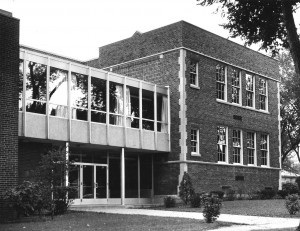
Clark School
In 1982, School District 101 closed the Maurice Clark elementary school, which was located at 46th and Franklin Avenue. This was due to declining enrollments and the growing cost of maintaining the 1920’s era building.
Two years later, the Village’s Recreation Department began leasing the building for its various programs. This arrangement continued until the mid-1990s when the School District decided it was time to sell the building and land. This left the Recreation Department with three choices: buy the building, curtail many of its award-winning programs, or relocate elsewhere.
After examining the condition of the school’s old boilers, electrical system, windows, roof, and other features, the Village decided that the aging building could easily require upwards of a million dollars in improvements, plus a million-dollar purchase price. Plus, there was no off-street parking. As a result, this option was not considered viable.
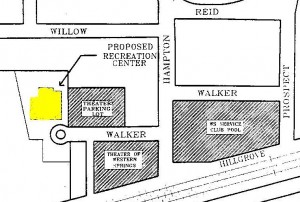
Proposed Rec Center Site
While curtailing programs was another option, this would have adversely impacted thousands of residents, many of whom had come to depend on the Center for daycare and other family-oriented activities, such as dance and music lessons, sports activities, and arts & crafts.
The third option was to relocate. In studying this possibility, the Village considered renting the then-vacant Corral building on the Lyons Township South Campus, building a township recreation center in concert with several other communities, as well as renting some vacant church facilities. It also looked at using land on Walker Street that was already owned by the Village, where it could construct a new facility.
This proposed building would encompass 26,000 square feet, including a full-size gym with locker rooms, multi-use facilities for aerobics and volleyball, and classrooms for daycare, dance, etc. It could also share the adjacent parking lot belonging to the Theatre of Western Springs. This would reduce the initial investment cost, but the final bill would still be close to $2 million.
While the need and financing for a new Recreation Center were discussed at more than 60 public meetings over a period of several years, opponents argued that there was a “rush to judgment”. And, while the projected operating costs were to be covered almost entirely by user fees and contractor rentals, some residents still objected. As a result, the Village scheduled an open meeting at the McClure gymnasium. But, opponents still circulated contentious handbills.
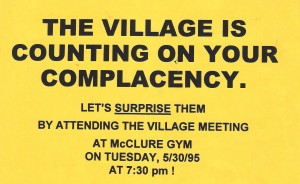
Anti-Rec Center Flyer
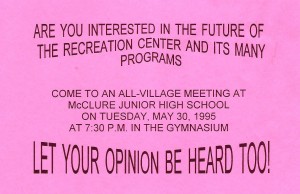
Pro-Rec Center Flyer
Proponents of the new facility were equally aggressive, circulating their own handbills.
The resulting open meeting was anything but dull. With the entire Village Board in attendance, several hundred residents were given the opportunity to ask questions concerning the plan, especially the financial aspects. While some had heard that a third of the center’s users were non-residents, the Village countered that the number was closer to 15%, the balance being residents. Others argued that the residents should have been allowed to decide the issue in the form of a referendum. In response, the Village noted that only $20,000 of the projected annual cost would be covered by tax revenue, with the overwhelming balance coming from user fees and contractor rentals.
Afterward, the Village Board met again and approved the plan. But, given the lead time for design work and construction, the new facility did not open until March 1997. Since then, the Center has operated very successfully, serving an entire generation of residents.
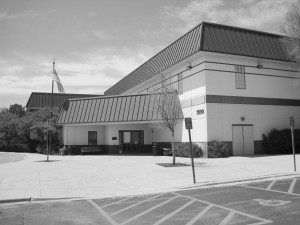
Recreation Center circa 2012
But what became of the old Clark School? The Western Springs Park District purchased what had been the playground area on the east side of the building and created what is now known as Clark Park. The old building itself was eventually demolished by the school district, with the resulting land being subdivided and sold as three residential lots.
